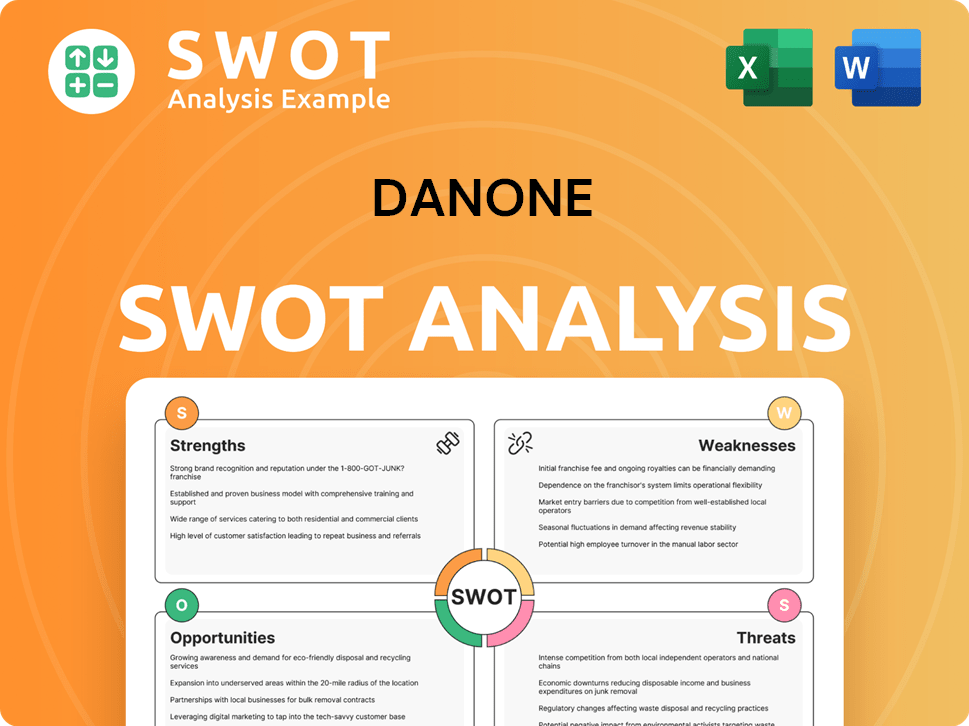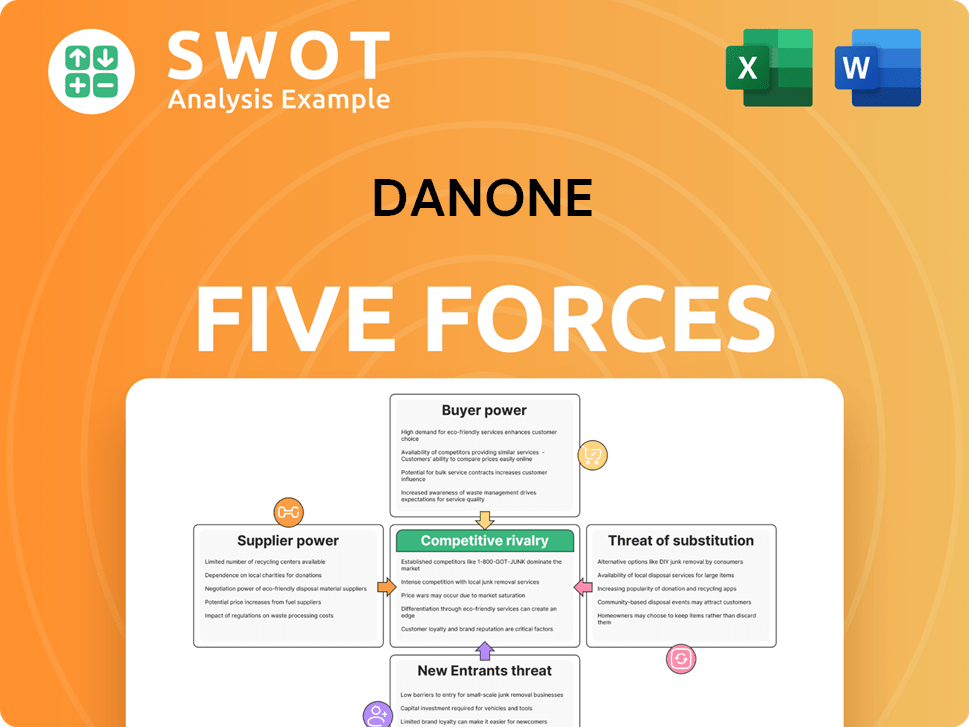Danone Bundle
How Does Danone Thrive in the Global Food Market?
Danone, a global powerhouse in the food and beverage sector, has consistently demonstrated its ability to adapt and lead. With a focus on health-oriented products and a presence in over 120 markets, Danone generated €27.6 billion in sales in 2023. Its strategic emphasis on essential dairy, plant-based products, specialized nutrition, and waters has solidified its market position.

This exploration into the Danone SWOT Analysis will uncover the operational intricacies of the Danone company, its core business segments, and its strategic evolution. Understanding the Danone business model is crucial for investors, customers, and industry observers alike. We'll examine how Danone's diverse portfolio of Danone brands and its commitment to innovation fuel its success, offering insights into its financial performance and future outlook, including its sustainability initiatives and impact on the environment.
What Are the Key Operations Driving Danone’s Success?
The Danone company structures its core operations around three main segments: Essential Dairy and Plant-Based (EDP), Specialized Nutrition, and Waters. This diversified approach allows Danone business to cater to a broad consumer base, offering products ranging from everyday essentials to specialized nutritional solutions. This structure also facilitates strategic focus and resource allocation, enabling Danone to adapt to evolving market demands and consumer preferences effectively.
The Essential Dairy and Plant-Based segment includes well-known Danone brands like Activia and Alpro, focusing on providing nutritious and sustainable options. Specialized Nutrition, featuring brands such as Nutricia, addresses specific health needs. The Waters division, with brands like Evian, prioritizes natural purity and sustainable water resource management. This operational setup supports Danone's commitment to health, sustainability, and innovation in the food and beverage industry.
Key to Danone's success is its extensive global supply chain, which integrates manufacturing facilities, logistics networks, and diverse sales channels. The company emphasizes local sourcing and production where possible, enhancing its responsiveness to regional market demands. This approach strengthens its relationships with local communities and supports its sustainability goals. Danone's operational efficiency is also driven by its commitment to innovation, allowing it to adapt to changing consumer preferences and market trends.
This segment includes brands like Activia and Alpro, focusing on fresh dairy and plant-based alternatives. It caters to consumers seeking nutritious and sustainable options. EDP leverages a vast network of dairy farms and plant-based ingredient suppliers, emphasizing responsible sourcing and sustainable agricultural practices.
With brands such as Nutricia, this segment addresses specific health needs across different life stages. It includes early life nutrition for infants and medical nutrition for patients with specific dietary requirements. This segment relies heavily on scientific research and development, collaborating with healthcare professionals.
This division, featuring brands like Evian and Volvic, provides natural mineral and spring water. It prioritizes natural purity and sustainable water resource management. The focus is on offering consumers healthy hydration options while minimizing environmental impact.
Danone's operational effectiveness is underpinned by its extensive global supply chain. It integrates manufacturing facilities, logistics networks, and diverse sales channels. The company's commitment to local sourcing and production enhances its responsiveness to regional market demands.
Danone's value proposition centers on providing healthy and sustainable food and beverage options. It emphasizes health through its specialized nutrition products and the nutritional value of its EDP offerings. Sustainability is a core focus, with initiatives in water resource management and responsible sourcing.
- Focus on health and well-being through nutritious products.
- Commitment to sustainability and environmental responsibility.
- Innovation in food and beverage to meet evolving consumer needs.
- Strong brand recognition and global presence.
Danone SWOT Analysis
- Complete SWOT Breakdown
- Fully Customizable
- Editable in Excel & Word
- Professional Formatting
- Investor-Ready Format

How Does Danone Make Money?
The Danone company generates revenue through the sale of its diverse product portfolio, focusing on its three core segments. In 2023, the company reported consolidated sales of €27.6 billion, showcasing its significant market presence and financial performance. The company's success is built on a foundation of strong brands and innovative product offerings.
The company's monetization strategies are centered on volume growth, strategic pricing, and product innovation. The company employs a tiered pricing strategy, offering a range of products from mass-market options to premium, specialized formulations, catering to various consumer purchasing powers and needs. Digital transformation plays an increasingly vital role, with e-commerce sales contributing to revenue growth and enabling direct-to-consumer engagement, particularly for specialized nutrition products.
The Essential Dairy and Plant-Based (EDP) segment was the largest contributor, accounting for 50% of total sales. Specialized Nutrition contributed 30% of sales, and the Waters segment represented 20% of sales. This diversified approach allows the Danone business to cater to a wide range of consumer needs and preferences, contributing to its overall financial health.
To understand how Danone operates, it's important to look at its revenue streams and monetization strategies. The company utilizes a multi-faceted approach to generate income and maximize profitability. For a deeper dive into the company's background, consider reading Brief History of Danone.
- Product Sales: The primary revenue stream comes from selling a wide array of Danone products, including dairy, plant-based, specialized nutrition, and bottled water.
- Volume Growth: Increasing the volume of products sold is a key strategy to boost revenue.
- Strategic Pricing: Implementing tiered pricing strategies to cater to different consumer segments and product types.
- Product Innovation: Developing new and value-added products, particularly in high-growth categories like plant-based alternatives and medical nutrition, to drive higher margins.
- Brand Equity and Distribution: Leveraging strong brand recognition and extensive distribution networks to maximize product penetration and market share.
- E-commerce: Expanding online sales and direct-to-consumer engagement, especially for specialized nutrition products.
Danone PESTLE Analysis
- Covers All 6 PESTLE Categories
- No Research Needed – Save Hours of Work
- Built by Experts, Trusted by Consultants
- Instant Download, Ready to Use
- 100% Editable, Fully Customizable

Which Strategic Decisions Have Shaped Danone’s Business Model?
The evolution of the Danone company has been marked by significant strategic shifts and milestones that have shaped its current market position. A crucial move was the 2007 acquisition of Numico, which significantly strengthened its presence in the specialized nutrition sector, particularly in early life and medical nutrition. More recently, the company has been streamlining its portfolio, including divesting non-core assets to focus on its core health-focused categories.
Danone's journey has also involved navigating operational challenges, such as supply chain disruptions and inflationary pressures. The company has responded by implementing efficiency programs and adjusting its pricing strategies to maintain profitability. These actions reflect Danone's commitment to adapting to market dynamics and ensuring sustainable growth.
Danone's competitive edge is built on several key pillars. Its strong brand portfolio, which includes well-known names like Activia and Evian, fosters considerable consumer trust and loyalty. The company's robust research and development capabilities, especially in specialized nutrition, enable it to innovate and offer scientifically backed products tailored to specific health needs. Furthermore, Danone benefits from economies of scale due to its global reach and large production volumes, which enhance cost efficiencies. Its dedication to sustainability and responsible sourcing also resonates with increasingly conscious consumers, improving its brand reputation and market differentiation. For a deeper dive into how the company approaches growth, consider reading about the Growth Strategy of Danone.
The acquisition of Numico in 2007 was a pivotal moment, significantly boosting Danone's presence in specialized nutrition. This strategic move expanded its portfolio and market reach. More recently, Danone has focused on portfolio optimization, including divestitures to concentrate on core health-oriented categories.
Danone has actively adapted to challenges such as supply chain issues and inflation by implementing efficiency programs and adjusting pricing. These actions demonstrate Danone's ability to respond to market pressures. The company continues to focus on innovation and sustainability to meet evolving consumer demands.
Danone's strong brand portfolio, including global brands, fosters significant consumer trust. Their extensive R&D capabilities, particularly in specialized nutrition, allow for innovative product offerings. Danone's global reach and commitment to sustainability further enhance its market position.
Danone is committed to sustainability, focusing on responsible sourcing and environmental impact reduction. These initiatives resonate with consumers and enhance brand reputation. The company's focus on plant-based foods also aligns with current consumer trends.
In 2024, Danone reported consolidated sales of approximately €27.6 billion, reflecting organic growth and strategic portfolio adjustments. The company's specialized nutrition segment continues to be a key growth driver. Danone is also focused on expanding its presence in plant-based products, which saw significant growth in recent years.
- Danone has a global presence, operating in numerous countries worldwide.
- The company's commitment to sustainability includes goals for reducing carbon emissions and promoting sustainable packaging.
- Danone continues to invest in innovation to meet evolving consumer preferences for healthier and more sustainable food and beverage options.
- Danone's marketing strategies emphasize brand building and consumer engagement through digital channels and partnerships.
Danone Business Model Canvas
- Complete 9-Block Business Model Canvas
- Effortlessly Communicate Your Business Strategy
- Investor-Ready BMC Format
- 100% Editable and Customizable
- Clear and Structured Layout

How Is Danone Positioning Itself for Continued Success?
The Danone company holds a prominent position within the global food and beverage industry, particularly in the fresh dairy, plant-based products, and specialized nutrition segments. Its strong brand recognition and significant market share contribute to high levels of customer loyalty. However, the Danone business operates in a highly competitive and dynamic environment, facing challenges from both established players and emerging startups.
Several risks impact the Danone company, including fluctuations in raw material costs, intense competition, and evolving consumer preferences. Regulatory changes concerning food labeling, environmental impact, and product safety also present potential challenges. To understand more about the ownership structure, you can read about the Owners & Shareholders of Danone.
The Danone company is a global leader in the food and beverage sector, with a strong presence in key categories such as fresh dairy, plant-based products, and specialized nutrition. It competes with major players like Nestlé and Unilever. The company's diverse portfolio and brand recognition contribute to its significant market share.
Key risks include fluctuating raw material costs, intense competition, and changing consumer preferences. The company faces challenges from both established competitors and agile startups. Regulatory changes concerning food labeling, environmental impact, and product safety also pose risks.
The Danone business is focused on strategic initiatives to sustain and expand revenue. The company aims to accelerate growth in high-potential areas like plant-based products and medical nutrition. Sustainability remains a core pillar, with ambitious targets for carbon neutrality and responsible resource management.
Strategic initiatives include accelerating growth in plant-based products and medical nutrition. The company is also focused on strengthening operational efficiency and supply chain resilience. Sustainability efforts include carbon neutrality and responsible resource management, expected to drive long-term value.
In its 2023 financial report, Danone reported strong performance, with like-for-like sales growth of 7%, driven by volume and mix. The company is focused on portfolio optimization and continued focus on health-oriented categories. The company's strategy includes a commitment to delivering consistent profitable growth.
- The company is investing in innovation, particularly in plant-based products and medical nutrition, to meet evolving consumer demands.
- Danone is focused on improving operational efficiency and supply chain resilience to mitigate future disruptions and manage costs effectively.
- Sustainability is a key focus, with ambitious targets for reducing its environmental footprint and promoting responsible resource management.
Danone Porter's Five Forces Analysis
- Covers All 5 Competitive Forces in Detail
- Structured for Consultants, Students, and Founders
- 100% Editable in Microsoft Word & Excel
- Instant Digital Download – Use Immediately
- Compatible with Mac & PC – Fully Unlocked

Related Blogs
- What are Mission Vision & Core Values of Danone Company?
- What is Competitive Landscape of Danone Company?
- What is Growth Strategy and Future Prospects of Danone Company?
- What is Sales and Marketing Strategy of Danone Company?
- What is Brief History of Danone Company?
- Who Owns Danone Company?
- What is Customer Demographics and Target Market of Danone Company?
Disclaimer
All information, articles, and product details provided on this website are for general informational and educational purposes only. We do not claim any ownership over, nor do we intend to infringe upon, any trademarks, copyrights, logos, brand names, or other intellectual property mentioned or depicted on this site. Such intellectual property remains the property of its respective owners, and any references here are made solely for identification or informational purposes, without implying any affiliation, endorsement, or partnership.
We make no representations or warranties, express or implied, regarding the accuracy, completeness, or suitability of any content or products presented. Nothing on this website should be construed as legal, tax, investment, financial, medical, or other professional advice. In addition, no part of this site—including articles or product references—constitutes a solicitation, recommendation, endorsement, advertisement, or offer to buy or sell any securities, franchises, or other financial instruments, particularly in jurisdictions where such activity would be unlawful.
All content is of a general nature and may not address the specific circumstances of any individual or entity. It is not a substitute for professional advice or services. Any actions you take based on the information provided here are strictly at your own risk. You accept full responsibility for any decisions or outcomes arising from your use of this website and agree to release us from any liability in connection with your use of, or reliance upon, the content or products found herein.